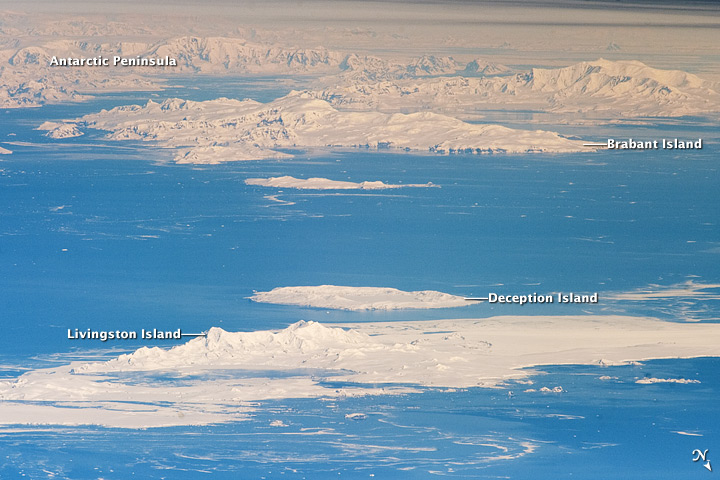
Astronauts Get Angled View of Antarctica

From NASA's Earth Observatory:
The inclined equatorial orbit of the International Space Station (ISS) limits astronauts to nadir views of Earth—looking straight down from the spacecraft—between approximately 52 degrees North latitude and 52 degrees South. However, when viewing conditions are ideal, the crew can obtain detailed oblique images—looking outwards at an angle—of features at higher latitudes, such as Greenland or, in this image, Antarctica.
While the bulk of the continent of Antarctica sits over the South Pole, the narrow Antarctic Peninsula extends like a finger towards the tip of South America. The northernmost part of the Peninsula is known as Graham Land, a small portion of which (located at approximately 64 degrees South latitude) is visible at the top left in this astronaut photograph.
Off the coast of Graham Land to the north-northwest, two of the South Shetland Islands—Livingston Island and Deception Island—are visible. Both have volcanic origins, and active volcanism at Deception Island has been recorded since 1800. (The last verified eruptive activity occurred in 1970.) Closer to the coastline of Graham Land, Brabant Island (not part of the South Shetlands) also includes numerous outcrops of volcanic rock, attesting to the complex tectonic history of the region.
The ISS was located over the South Atlantic Ocean, approximately 1,800 kilometers (1,100 miles) to the northeast when this image was taken. This long viewing distance, combined with the highly oblique angle, accentuates the shadowing of the ground and provides a sense of the topography similar to the view you get from an airplane. It also causes foreshortening of features in the image, making them appear closer to each other than they actually are. For example, the distance between Livingston and Deception Islands is approximately 20 kilometers (12 miles).
Get the world’s most fascinating discoveries delivered straight to your inbox.
 Live Science Plus
Live Science Plus






